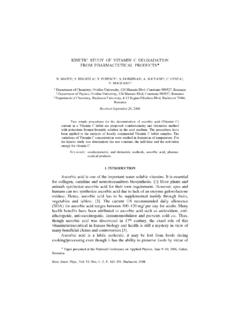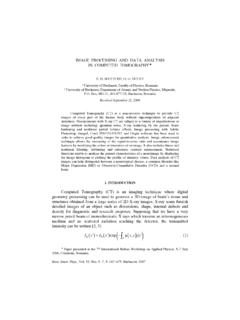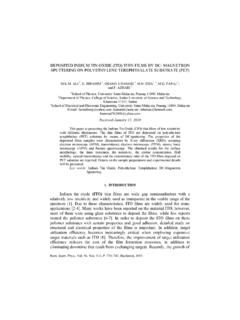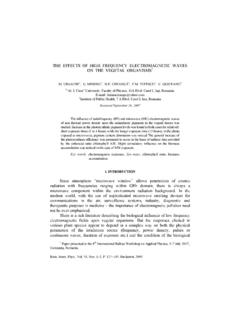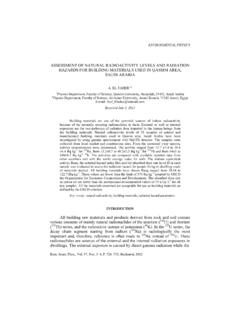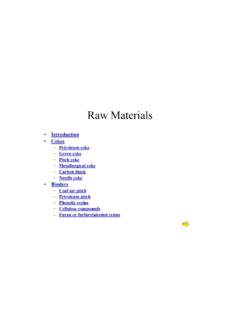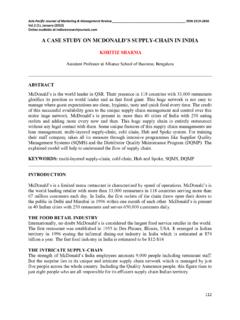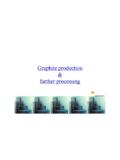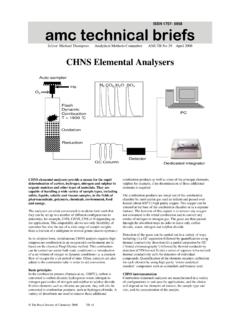Transcription of STUDY ON PHYSICAL-CHEMICAL PROPERTIES OF …
1 STUDY ON PHYSICAL-CHEMICAL PROPERTIES OF petroleum COKES* S. BIRGHILA1, I. CARAZEANU POPOVICI1, A. DUMITRU2 1 Ovidius University, Chemistry Department, Constan a, 900527, Romania E-mail: 2 Ovidius University, chemical Technology and Engineering Department, Constan a, 900527, Romania, E-mail: Received September 10, 2010 The calcined petroleum cokes are used in production of aluminum anode-grade, graphite electrode, needle-grade, titanium dioxide pigments. petroleum coke (green and calcined) is produced by the high pressure thermal decomposition of heavy petroleum process streams and residues. Green coke undergoes additional thermal processing to produce calcined coke . Various PROPERTIES of calcined cokes from several refineries were analyzed. coke PROPERTIES evaluated are: moisture, volatile carbon matter, ash and metals (Mo, Ni, Cu, Zn). The results of investigation showed that all coke contains the highest content of nickel (625 to 5353 ppm) which is the most represented metal component in the coking feedstock.
2 The PHYSICAL-CHEMICAL PROPERTIES showed that analyzed coke has a low volatile matter content, low ash and metallic content in samples A and C. Therefore, coke A and C can be used in production of anodes for the aluminum or as carburizer in the foundries. Due to the high content of the ash and metallic content, coke B, can be recommended as burning agent. Key words: aluminum anode-grade, petroleum coke , moisture, volatile carbon matter, metals. 1. INTRODUCTION The petroleum coke belongs to a group of materials with high carbon content. It is produced by coking of feedstocks obtained from residue of primary and secondary oil refining processes [1]. At present, these are three different types of coking processes: delayed, fluid and flexicoking, the he delayed coke is mostly used. coke products from a delayed coker are classified as shot, sponge or needle coke depending on their chemical and physical characteristics. Shot coke , almost always solid as fuel is hard, having spherical form and physically produced through precipitating asphaltenes; sponge coke , mostly used for anode-grade is dull and * Paper presented at the 11th International Balkan Workshop on Applied Physics, July 7 9, 2010, Constanta, Romania.
3 Rom. Journ. Phys., Vol. 56, Nos. 7 8, P. 976 982, Bucharest, 2011 2 STUDY on PHYSICAL-CHEMICAL PROPERTIES of petroleum cokes 977 black, having porous, amorphous structure; and needle coke , not used in anode production is silver-gray, having crystalline broken needle structure, and chemically produced through cross linking of condensed aromatic hydrocarbons during coking reactions. Green petroleum cokes are mostly used as utility fuels and as feedstocks for further upgrading calcinations. The calcined petroleum cokes are used in production of aluminum anode-grade, graphite electrode, needle-grade, titanium dioxide pigments. The carbon anodes used in the production of aluminum are manufactured by carbonization of a blend of petroleum coke with a small proportion of coal tar binder pitch. Impregnation with more pitch is commonly used to produce the dense anodes needed to meet the required performance standards.
4 Consumption rates of the anodes in the molten fluoride salt electrolysis cell are high, approaching t of carbon for each tonne of aluminum produced [2]. Hence, large quantities of coke are required for carbon anode manufacture to satisfy the demands of the indigenous aluminum industry. There are a number of factors which determine the quality of petroleum coke : such density, metal and sulphur content, electrical resistivity. Knowledge of structure parameters also contributes to characterization and utilization of petroleum coke [3-4]. Impurity levels in petroleum cokes have been progressively increasing in recent years as the refineries have been obliged to accept a higher proportion of heavy sour crudes. This trend, and changes in refinery practice dictated by the economics of the petroleum market aimed at maximizing the yield of lighter high-value products, have resulted in an increase in the S content of the petroleum coke [5].
5 Impurities in the crude oil become concentrated in the coke and can have undesirable effects on aluminum production. Metal impurities, such as V and Ni, catalyze carbon oxidation reactions and lead to higher carbon consumption in the electrolysis cell. Other impurities collect in the refined aluminum and can lower its value. An alternative supply of anode coke is required to supplement, or eventually replace, calcined petroleum coke supplies [6-9]. Casada, Rolle, et al. [10] investigated the influence of nickel on reduction cell anodes. Nickel alone does not significantly effect anode, but including anode butt material increased CO2, reactivity. Leach et al. [11] evaluated calcined coke and anode core PROPERTIES to predict carbon consumption and anode performance in aluminum reduction cells. Calcined cokes having a range of PROPERTIES can produce quality prebake anodes that yield low, stable carbon consumption. Concern over release of certain trace elements to the environment as a result of coke utilization has made the determination of these elements an increasingly important aspect of coke analysis.
6 This paper presents the results of investigation of PHYSICAL-CHEMICAL PROPERTIES of calcined petroleum coke , used in aluminum anode-grade carbon or as carburized in the foundries. coke PROPERTIES evaluated are: moisture, volatile carbon matter, ash and metals (Mo, Ni, Cu, Zn) S. Birghila, I. Carazeanu Popovici, A. Dumitru 3 978 2. EXPERIMENTAL Sample Representative samples of petroleum cokes for this STUDY have been obtained from various refineries (A, B and C). The cokes were produced by delayed coking process from feedstock consisting pyrolytic residue of oils. Calcination was performed by thermal treatment of green coke at 11000 C during 3 hours. Determination of moisture and volatile matter content Moisture content was determined by heating the coke samples at 1100 C to constant mass and volatile matter content was determined applying the standard ASTM D 3175 method [12]. Determination of ash content The ash content was determined by first drying 5g of coke at 1100 C to constant mass and then ashing it at 7500 C for 2 hours, until constant ash mass was obtained.
7 Determination of metal content Metal content was determined applying the standard ASTM D 3686 method using an atomic absorption spectrometry whit flame atomizer [13-14]. Atomic absorption spectrometry is still one of the most versatile analytical tools. This technique has been applied to the determination of many elements in several kinds of samples, particularly using flame atomizers (FAAS). The sensitivity in FAAS could be improved when the atomization step occurs in a heated tube; a conventional air-acetylene flame has been used for this purpose. The main advantage of this system is the enhancement on sensitivity due to the increase on the concentration of atoms in the optical path [15]. A ZEENIT 700 atomic absorption apparatus equipped with air-acetylene flame was used to determine individual elements. Calibration standards are prepared from stock solutions; the corresponding absorbance response for each standard is plotted versus concentration for calibration.
8 Samples responses are compared directly with the calibration curve. Metal calibration curves have linear shape in 0 30 mg/L range for Ni and 0 10 mg/L for Mo and 0 6 mg/L for Cu and Zn. Analyses were made in triplicate and the mean values are reported. Table 1 summarized the instrumental parameters to be used. Table 1 Instrument parameters Element Wavelength, nm Oxidant-Fuel Mo Air-C2H2 Cu Air-C2H2 Ni Air-C2H2 Zn Air-C2H2 4 STUDY on PHYSICAL-CHEMICAL PROPERTIES of petroleum cokes 979 3. RESULTS AND DISCUSSION Typical ranges of calcined coke PROPERTIES for aluminum anode-grade specifications are listed in the Table 2 [16]. Table 2 coke PROPERTIES for aluminum anode-grade Property Calcined S wt % Ash wt % V [ppm] 165 350 Ni [ppm] 120 350 Volatile matter wt % < Table 3 summarizes the results of analyses of coke PHYSICAL-CHEMICAL PROPERTIES . Table 3 Cokes PHYSICAL-CHEMICAL PROPERTIES Property A B C Ash wt % Volatile matter wt % Moisture wt% The relatively low values of moisture and volatile matter content indicate that the calcination process was successful.
9 It is advisable to have the carburizer,s volatile matter content below 1% due to risk of possible explosion in contact with the melt. Volatile matter content of petroleum cokes analyzed varies in the range , the limit of maximum is frequently imposed in order to be used as anode material. The volatility differences are not significant between the three types of petroleum cokes. The volatility measures lead to significant considerations regarding petroleum coke structure and reactivity. All samples analyzed are low in moisture, the content ranges between %. The ash content indicates the presence of inorganic admixtures in coke . The analyzed sample contains % of ash, in which the content of metals Mo, Ni, Zn and Cu as micro components of coke was determined (Figure 1). S. Birghila, I. Carazeanu Popovici, A. Dumitru 5 980 04080120160 Concentration [ppm]ABCP etroleum cokeCu -a- 050100150200 Concentration [ppm]ABCP etroleum cokeMo -b- 0100200300 Concentration [ppm]ABCP etroleum cokeZn -c- 0200040006000 Concentration [ppm]ABCP etroleum cokeNi -d- Fig.
10 1 Metals content in petroleum cokes: a) Cu; b) Mo; c) Zn; d) Ni. There are differences between calcined cokes analyzed as a function of crude oil source. However the ash chemistry of petroleum coke remains significant due to issues of slagging and fouling, and traces metal emissions. The low content of ash and microcomponents in samples A and C is advisable in carburizers. In production of anodes for the aluminum the ash content should be kept below A consequence of high ash content is formation of higher quality of slag, which can cause difficulties in operation and lower utilization. So, utilization depends on carburizer s chemical composition, its reactivity and its physical PROPERTIES . On the other hand, possibility of carburizer s dissolution is determined by physical PROPERTIES , microstructure and by the distribution and type of structural elements. The results of investigation showed that all coke contains the highest content of nickel (625 to 5353 ppm) which is the most represented metal component in the coking feedstock.


